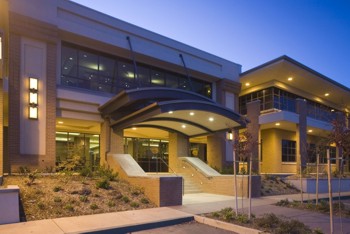BJG Architecture + Engineering Expands to Park from Reno
BJG Architecture + Engineering Expands to Park from Reno

Move to Hacienda Brings Clients and Current Projects Closer
When your company tag line is "responsive by design," it's good to be able to get to the job site in 30 minutes. But as the Reno practice of BJG Architecture + Engineering started to spill down into the Central Valley, the principals found that some of their newer projects were a four-hour drive away. "Our clients were asking us to be closer," recalls the firm's vice president Teresa Kulesza, "so last June I came from Reno to open this office" in Hacienda Business Park at 3875 Hopyard Road.
Despite the disruptive economic news lately, Kulesza is confident the expansion took place at a good time. "I think we'll grow here. We're relatively new, but we have been doing projects here for 10 to 15 years," she says. For instance, the firm just finished a warehouse in Tracy, 530,000 square feet of distribution space under one roof. But there's quite a bit of variation, and each project is specifically designed to meet client needs. A previous local building was 160,000 square feet, while the next one is 1 million square feet. "There's no one set building that would work for every tenant," she notes. "It depends on the land and who is going to be using the space."
As for the market in general, Kulesza passes on the word from the forecasting luncheons she's attended recently: "Nobody knows, everyone is waiting to see what's going to happen," she reports. Signs are pointing in a positive direction, however. "Developers are still moving forward with their plans. Right now we're working on the preliminary stages of the sister building next to the 530,000 square foot Tracy warehouse. It's the same size, right next door. The developer may not go too far with these plans unless there is movement on the first structure, but he is still moving ahead, getting the next building on line to move into construction. I haven't seen a slowing down or stopping of plans."
What she has noticed about the Tri-Valley area is the attention paid to LEED (Leadership in Energy and Environmental Design) criteria, the U.S. Green Building Council's voluntary rating system for sustainable buildings. "People here are willing to be at the forefront of the sustainability movement. There's no wait-and-see posture on this issue," she remarks. "Livermore requires each new building to have a minimum number of points on the LEED checklist. It's great to see these standards being embraced." Pleasanton, too, requires projects to use LEED as part of their design process.
Kulesza is enjoying her new environment, both professionally and personally. "Being in Hacienda puts us in the middle of Pleasanton and close to our Central Valley projects," she explains. "The building we occupy is an open suite with lots of natural light. It's beautiful space, and it helps fuel our creativity." She cites another advantage: showers and locker rooms in the building, "so I can run at lunch, clean up, and then get back to work." On weekends, it's trekking off to new locations that keeps her busy. "If you go 30 minutes in any direction you're in a different place. There's so much to do here," she enthuses.
Also in this issue...
- For FrontRange, Life Is More Challenging After the Turnaround
- BJG Architecture + Engineering Expands to Park from Reno
- Business Bits
- Executive Profile: Paul Larson, Contractor Has Local Roots, Broad Horizon
- Retirement Community Takes Reservations
- San Jose Stealth are Ready to Take on Higher Profile
- East Bay Innovation Engines Moving Economy Forward
- Bay-Friendly Garden Tour Highlights Low-Impact Landscaping Techniques
- Alameda County's Guaranteed Ride Home Provides Free Emergency Rides for Savvy Commuters
- Open Heart Kitchen is Feeding A Growing Need
- Hacienda Index
- Calendar




